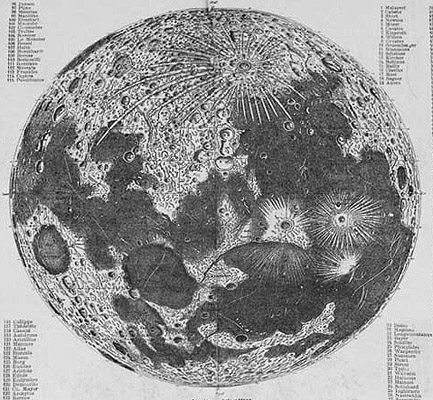April 3, 2014
French Moon

image by Chuck Wood
Classical studies of the Moon from the late 1700s and 1800s were most famously done in Germany (Schröter, Lohrmann, Beer and Mädler, and Schmidt (who did much work in Athens). From 1876 (Neison and then Elger and Goodacre) to 1955 (Wilkins and Moore), England was the center of lunar mapping. What about other nations? Through the inspiration of famed astronomy popularizer Camille Flammarion (1842-1925), French lunar studies spread to Delmotte, Lamech and culminated in Georges Viscardy's massive Atlas-Guide Photographique de la Lune. Flammarion was the David Levy of his day - a tireless observer and passionate advocate for astronomy. This chart of the Moon (drawn by Lecouturier and Chapuis) appeared in the 1881 edition of Flammarion's book Astronomie Populaire. The map shows a certain flamboyant simplicity and Italian influence (spaghetti-like rays from Tycho)!
Chuck Wood
2014 Update: This LPOD originally appeared in the first weeks of LPOD's existence on Jan 20, 2004. I googled the authors of this map to see if more information is available than I could find 10 years ago. I can't find the the map online but did discover that Lecouturier and Chapuis wrote a 102 page book, La Lune. Description et topographie, and a copy was just sold March 17, 2014 in the Canadian version of eBay for 74 Euros. Did an LPOD reader purchase it? Another copy is for sale on the UK eBay for 250 Euros! This listing has a publication date of 1860, but the Canadian listing says there is no date given. Jules Verne's All Around the Moon says that Barbican only took two lunar atlases to the Moon, that of Beer and Madler and the clear and correct 1860 map prepared by Lecouturier and Chapuis. And 1860 is also given as the publication date in the Moon-Wiki. So, 1860 it is!
Yesterday's LPOD: Young And Old
Tomorrow's LPOD: An Unfamiliar Earth View



